For a number of years I’ve been concerned with potential health risks from breathing in fumes from Fused Depostion Modeling (FDM, also called FFF, Fast Filament Fabrication and Material Extrusion) printing. I’ve overseen tests of filament where materials did not correspond to their Material Safety Datasheets and read about possible issues from fumes and UFP’s. I’ve worried about additives and certification. On the whole I think people are rather cavalier about safety in 3D printing. But, you don’t know now what kind of filament that you’ll be using later. And Frankly, especially with low quality filament you never really know what you’re extruding. In most cases you should be OK if you’re in a well ventilated room. But, I say should because there just isn’t any research on long term exposure to these things. You may be printing at too elevated temperature and the material may be releasing any number of fumes in your home or office. Thats why unequivocally you should always place your 3D printer under a fume hood or ensure that it is completely enclosed and that fumes are vented through Carbon and HEPA filters. As an added bonus you shall see that your failure rates decrease and that you will get better 3D prints this way. Please buy or make a fume hood or propper enclosure today.
I applaud more research on 3D printing safety and I’m sad that much of what there has been done is shoddy so far. A new paper by Aleksandr Stefaniak of the US National Institute for Occupational Safety and Health (NIOSH) part of the CDC is a benchmark for how such investigations should be done. In this paper 3Dimensional Printing with Nano‐Enabled Filaments Releases Polymer Particles Containing Carbon Nanotubes into Air, from the publication Indoor Air, Stefaniak and his team of 15 co-authors look at Carbon Nanotubes and Carbon Nanotube filament. Single Walled Carbon Nanotubes are rolled up sheets of carbon rolled up into a cilinder of around 50 nm to 250 nm in size. The carbon sheet itself is called graphene which itself is a matt of carbon atoms, one atom thick, laid out in a hexagonal pattern. These graphene structures can be changed to build many different nanotube structures which all have different properties. These materials have exceptional properties in stiffness, strength, conductivity and give people the option on the atomic level to create materials which have unique performance and propeties. There is a lot of excitement about nanotubes and graphene but also some real worry. Things at the nanoscale are very very small. How small? Your fingernail grows a nanometer per second. A nanometer is a billionth of a meter. So these teeny tiny interesting particles can do amazing things, such as penetrate your nasel barrier and end up inside of your brain. People are saying that nanotubes are a health risk and could be toxic. But, they’re also super hyped and amazing so others go on putting them in anything they can without a care in the world.
In 3D printing the nanotubes they often add very little in actual performance to the filament at the moment but this could indeed change. The NIOSH team looked at commercially available ABS, PLA and PC filaments with carbon nanotubes in them. The result of the study was that “respirable polymer particles” containing carbon nanotubes were released during printing and that “it is estimated that 7.2 % of these respirable particles could deposit in the alveolar region of the lung.” The paper then goes on to say that “If CNT (carbon nanotube) containing polymer particles are hazardous, it would be prudent to control emissions during use of these filaments in industrial or other environments (homes, etc.) to prevent exposure.” So yes you’ll breathe in particles containing carbon nanotubes if you’re in a room with a printer printing out a material containing carbon nanotubes. And yes, you should stop this by controlling the emissions.
The study looked at the regular filaments without carbon nanotubes and saw: “Particles emitted during printing with base polymer filaments were clusters of spherical nanoscale particles that had a soot -like appearance.” Contast this with the “the compact submicron to micronscale particle morphology is a combination of polymer and CNTs.”
“Peak number concentrations up to 10 7 particles/cm 3 were observed in chamber testing, indicating all filaments, regardless of additives, emitted a large number of particles during printing.”

“Figure 6 is scanning electron micrographs of aerosol particles collected during 3 -D printing. Printing with CNT -containing filaments released particles having two distinct morphology and size regimes: diffuse clusters of nanoscale polymer particles similar to thatseen for the base polymer filaments, and larger solid particles in the submicron to micronscale size range, some of which contained CNTs (Figure 6a , c, and e).”

“Figure 7 is scanning electron micrographs of the surfaces of printed objects. All objects printed using CNT -containing filaments had CNTs visible on the surfaces whereas objects printed with ABS, PLA, and PC filaments did not.”
Additionally:
“As shown in Figure 7, objects printed with CNT -containing filaments had CNTs protruding visibl y onto their surfaces. If these objects were further processed by abrasive processes, it could present an inhalation hazard if not performed properly under controlled conditions. For example, it is well known that disturbing composite surfaces by sanding or grinding or disrupting the inner volume by drilling or machining can generate aerosol that contains CNTs”
The team then looked at “particles having sizes of about 0.5 to 1 µm” which was the size of the clusters of polymer carbon nanotubes.
“For all filaments, the proportion of CNT -containing polymer particles that could deposit in the respiratory tract …from 0.523 to 1.037 µm was 6.51% (range: 4.12 – 9.96%), 5.74% (range: 5.70 – 5.86%), and 7.15% (range: 6.11 – 8.92%) for the head, tracheobronchial, and pulmonary regions, respectively.”
“The fraction of CNT -containing polymer particles that could deposit in the lung is predicted to range from 6.11 to 8.92% for the pulmonary region, which is important because clearance from this region is generally very slow and deposition there would permit prolonged persistence.”
“Once deposited, free CNTs that are not cleared are known to be biopersistent in the lung and may induce inflammatory and fibrotic alterations and changes in RNA expression.”
Before the paper comes to the conclusion that:
“While 3 -D printing and nanotechnology are converging to create new possibilities in polymers, our data indicate that material extrusion printing with CNT -containing filaments can release polymer particles that contain CNTs into air. If CNT -containing polymer particles are shown to be hazardous, it would be prudent to control emissions during use of these filaments. “
Inflamatory alterations sounds a bit vague and not terrible. But particle depostions in the lung can cause edema, asphyia, cancer and emphysema. The particles in the lung hazard that you most probably have heard of is asbestosis. Asbestosis is the disease, no known treatment, that you get from breathing in particles of asbestos. Another scenario, fibrotic alterations are scar tissue on your lungs that make it harder for you to breathe, for a while. Clearly we should find other materials to make our filament conductive. We should all 3D print using enclosures as well. But, even if we do these nanotubes may become disloged and have other subsequent effects. Carbon nanotubes may yet be the best whiz bang thing but its very doubtful that we should be adding them to filament.
Subscribe to Our Email Newsletter
Stay up-to-date on all the latest news from the 3D printing industry and receive information and offers from third party vendors.
You May Also Like
3D Printing Financials: Fathom Struggles in Financial Quicksand During Critical Transition
Facing a year of key transitions and financial pressures, Fathom (Nasdaq: FTHM) has filed its annual report for 2023 with the U.S. Securities and Exchange Commission (SEC). The document outlines...
Latest Earnings Overview for Australian 3D Printing Firms Titomic and AML3D
Australian 3D printing manufacturing firms Titomic (ASX: TTT) and AML3D (ASX: AL3) reported their financial results for the period from July to December 2023, marking the first half of their...
3D Printing Webinar and Event Roundup: April 7, 2024
Webinars and events in the 3D printing industry are picking back up this week! Sea-Air-Space is coming to Maryland, and SAE International is sponsoring a 3D Systems webinar about 3D...
3D Printing Financials: Unpacking Farsoon and BLT’s 2023 Performance
In the Chinese 3D printing industry, two companies, Farsoon (SHA: 688433) and Bright Laser Technologies, or BLT (SHA: 688333), have recently unveiled their full-year earnings for 2023. Farsoon reported increases...































